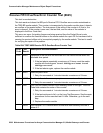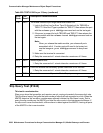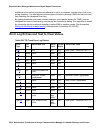
TIE-TRK (Analog Tie Trunk)
Issue 1 June 2005 2303
A tie trunk port can also be administered as an access endpoint which is a non-signaling
channel with a voice-grade data bandwidth. Tie trunk maintenance employs up to 6 tests,
depending on the hardware involved, to monitor the operating condition of the trunk and its
connections. The port must be idle for these tests to run. If an incoming call seizes the port
while a test is in progress, the test aborts and the call proceeds (except for TN497).
The test are as follows:
1. NPE Crosstalk Test—Verifies the switch connection operation of the circuit pack. It verifies
that the trunk circuitry talks only on the selected time slot on the TDM Bus and that it never
crosses over to time slots reserved for other connections.
2. Loop Around and Conference Circuit Test—Verifies the transmission operation of the circuit
pack. It verifies that signals are transmitted to and from each port (Loop Around within the
port), and it tests the conference capabilities of all ports.
This test may fail due to noise induced by adjacent electric power lines. Customers having
this problem should resolve it with their local power company. To temporarily alleviate the
alarm caused by the failure of this test, the test may be disabled from trunk administration
test field.
3. Several seizure tests, including the following:
● Tie Trunk Seizure Test verifies the seizure capabilities of the circuit pack. For the
TN2140B circuit pack, this test activates the M lead and checks for a response from the
distant end within 10 seconds. This test ABORTS on trunk ports administered as access
endpoints.
● Seizure Test (for TN497 circuit packs only)—Verifies the seizure capabilities of the circuit
pack. This test seizes the trunk and outpulses a “pause.” The port reports the result of the
seizure attempt uplink. The test can be disabled via Trunk Group Administration.
4. EPF, M, and E Lead Test ABORTS on trunk ports administered as access endpoints. This
test consists of two parts:
● E lead test—Checks for the proper activation and deactivation of the port’s E lead.
● M lead test—Checks the M lead EPF current flow. The results of this test allow for
distinguishing between circuit pack and external facility failures.
5. Port Audit Update Test (Audit & Update Test for the TN497 circuit pack)—Sends
non-disruptive administrative updates to the circuit pack with no expected response. The
test updates the translation information on individual ports of the Tie Trunk. Except for the
TN497 circuit pack, these updates include:
● Immediate, automatic, wink start, or delay dial; for the TN2140B,continuous-seize-ack
● For the TN2140B, continuous or discontinuous.
● Rotary or DTMF senderization in or out
● Disconnect timing
● DMTF time slot


















